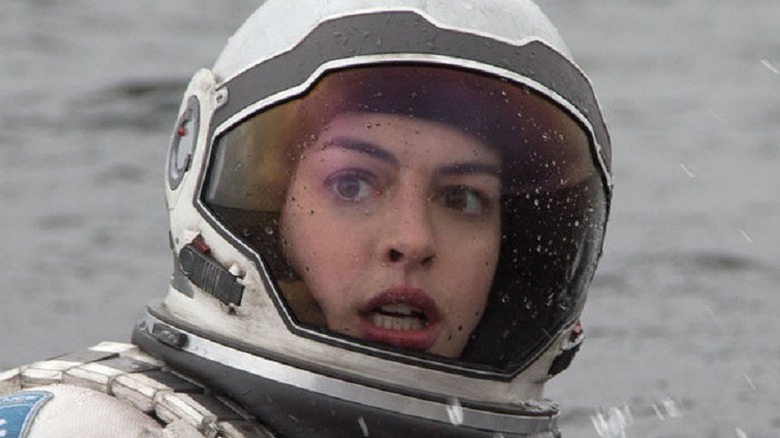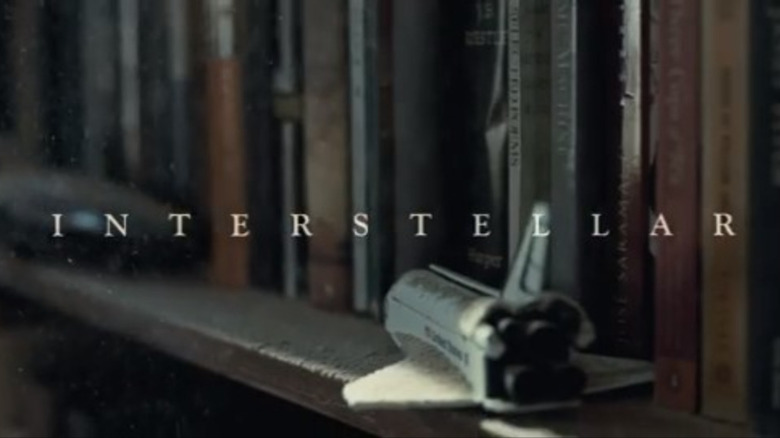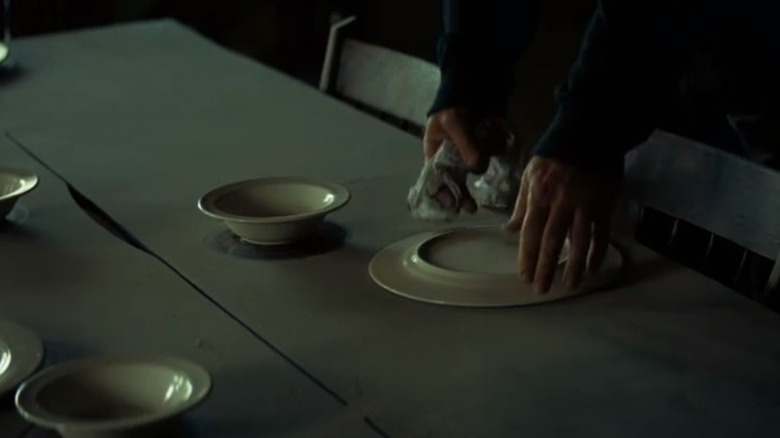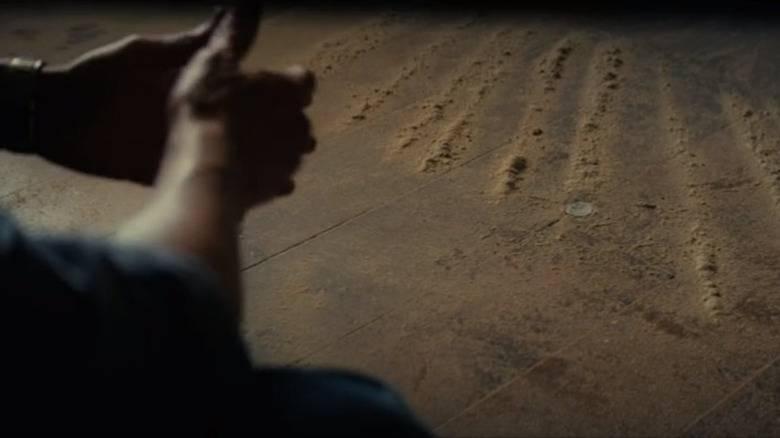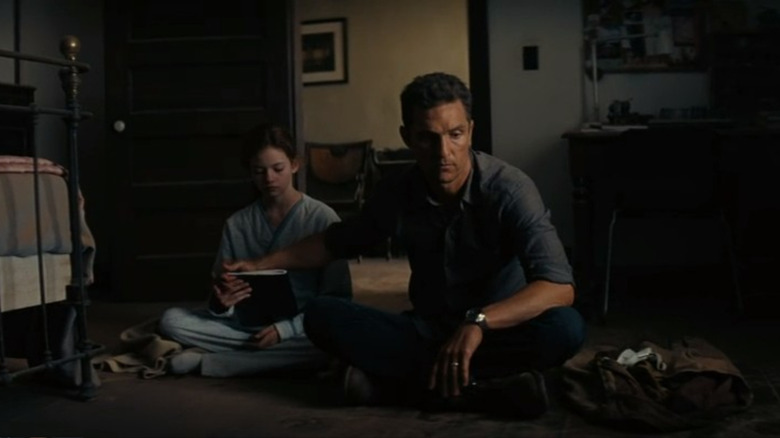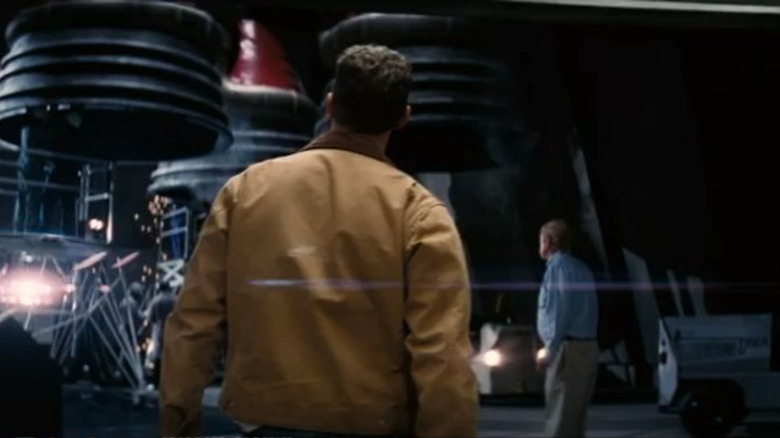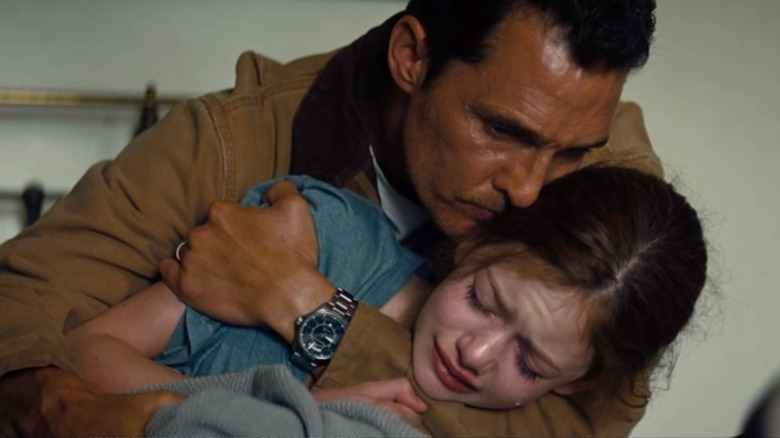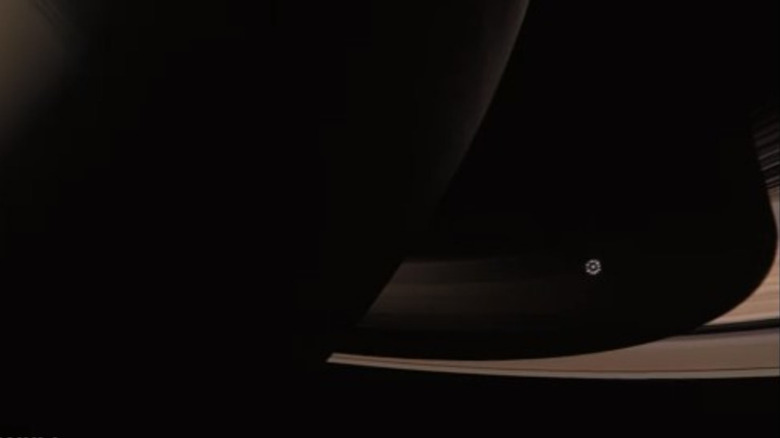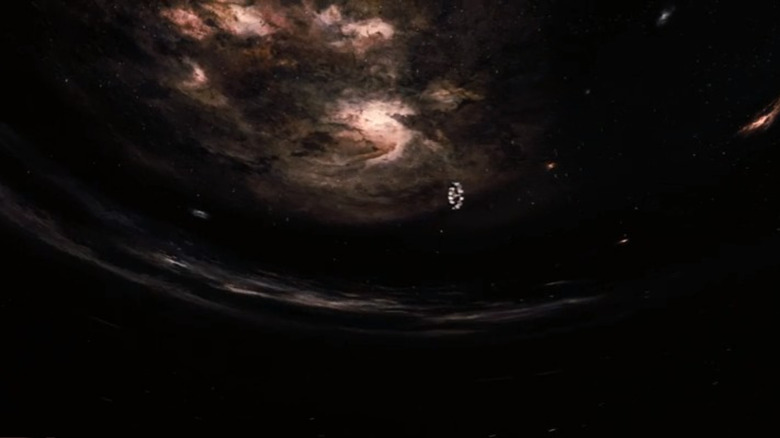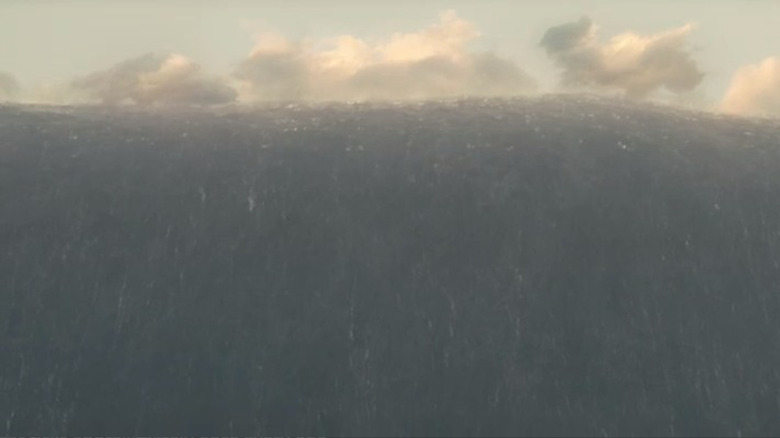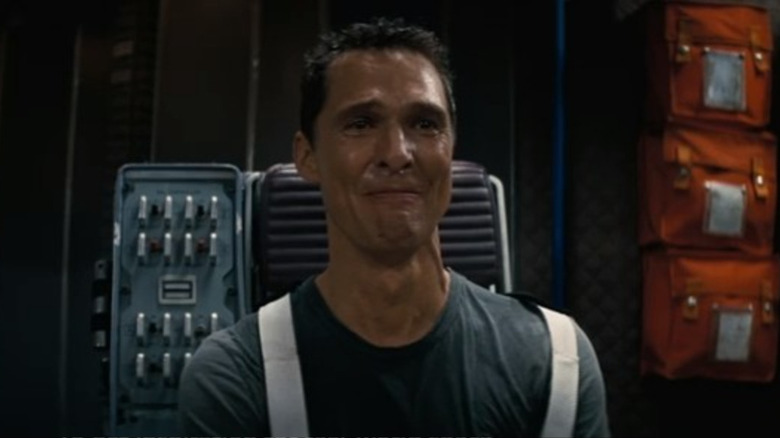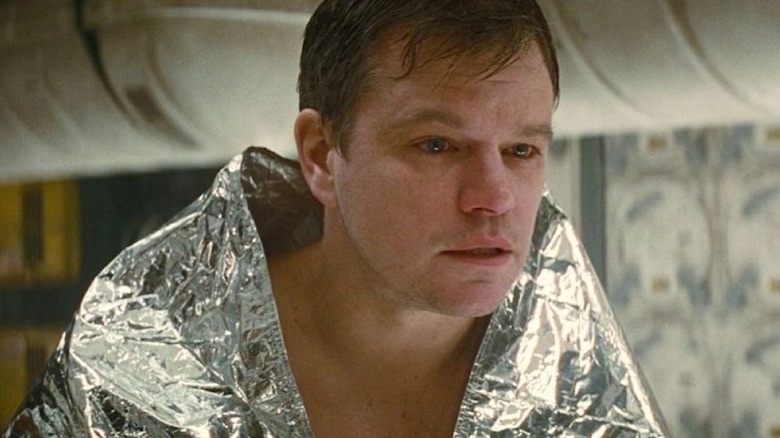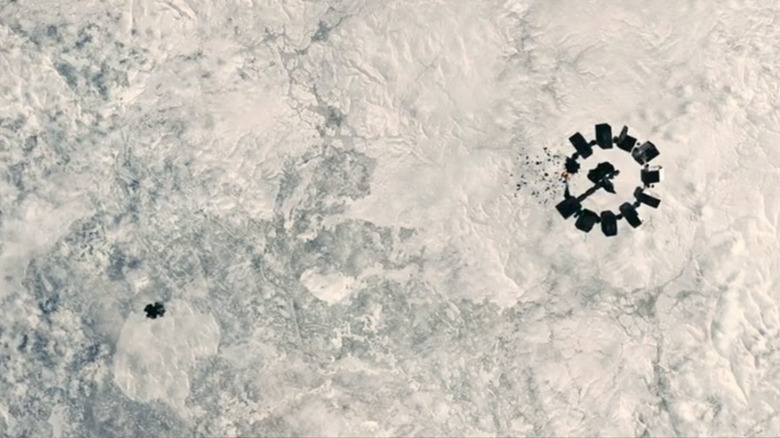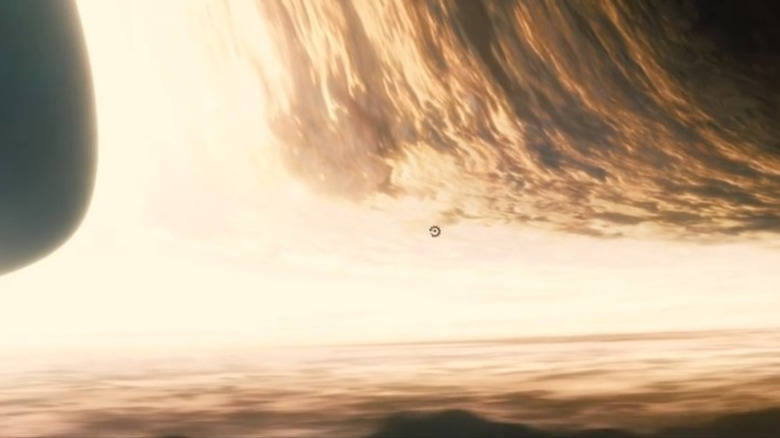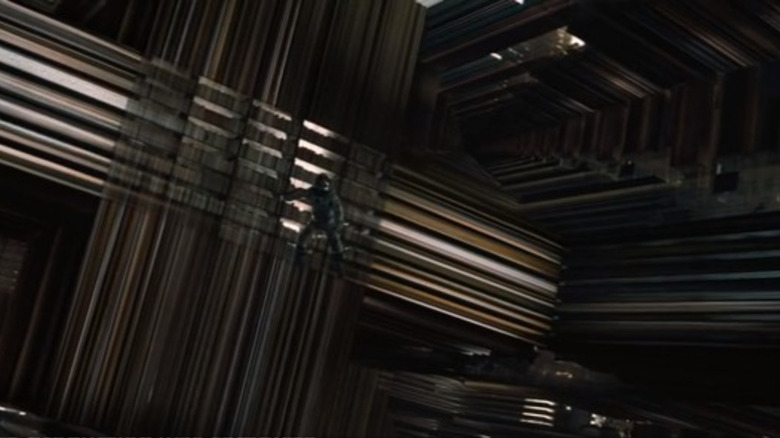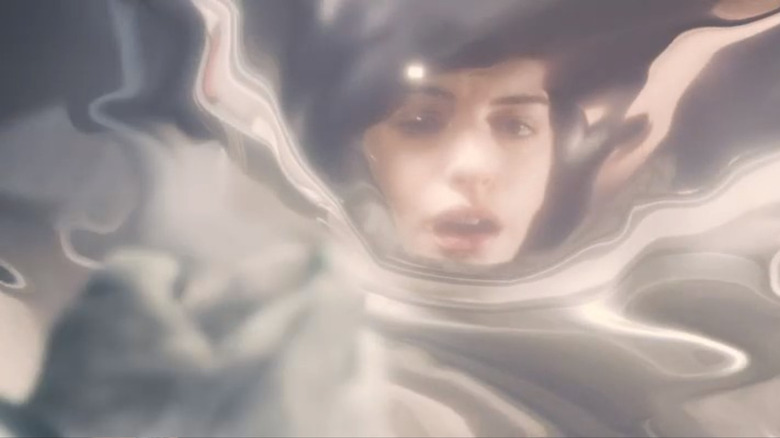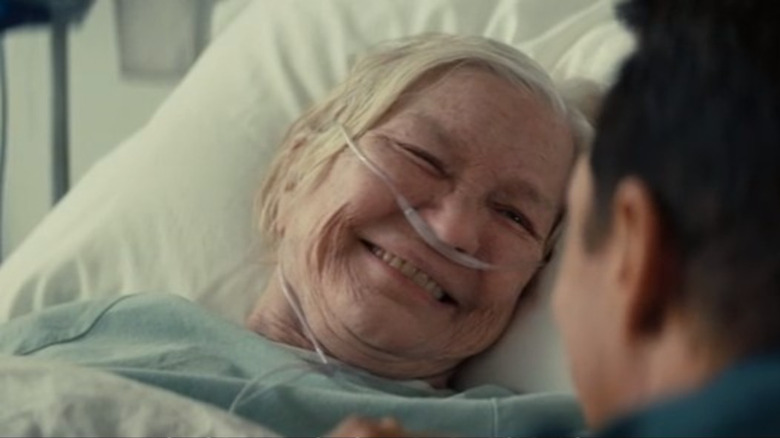The Most Pause-Worthy Moments In Interstellar
Christopher Nolan's "Interstellar" is a modern classic, grandiose and emotionally compelling at the same time. In the film, the slow, building consequence of climate change is that a mysterious blight is destroying all of the planet's harvestable crops one by one (a premise that's become even more unsettling and relevant in the eight years since the film's release). It's as mind-bending and twisty as many of Nolan's other epic films like "Tenet" or "Dunkirk," but has at its core a straightforward, gripping tale of survival that we share as a species. It's a rallying cry for science and imagination as our collective salvation.
Between the believable performances from Matthew McConaughey and a deep bench of stars, the booming score by Hans Zimmer, and the IMAX-enhanced cinematography and effects, "Interstellar" is the kind of epic movie experience that feels like the closest thing there is to go to space without actually going. It wears its heart on its sleeve — especially during the purposefully corny "love is the strongest force in the universe" speeches — but mostly lets the characters stay quiet and in awe of the spectacular sights they're taking in along with the audience. It's full of heart-rending goodbyes and tearful reunions, from the dying Earth to planets orbiting a distant black hole. These are the most pause-worthy moments in "Interstellar."
The title shot drops hints
The title shot of "Interstellar" is instantly memorable, essentially presenting us with a small diorama of the movie to come. The toy spaceships, which make sense as remnants of Cooper's erstwhile NASA career, are the least subtle, but the bookshelf they rest on will turn out to be even more key to the salvation of humanity. The threat to humankind, of course, is the dust that is already covering the objects we see in the opening shot of "Interstellar."
For all of its grandeur and sweeping visuals, this image speaks to how concise a story "Interstellar" turns out to be. The model ships spiritually signal the earnest enthusiasm for scientific inquiry central to the story, and they combine with a child's bookshelf in an image that sums up the dreamlike, wrapped-around-in-time quality of the finished product. "Interstellar" is at once dusty and gloomy, full of wonder, and circular in its own indelible way.
A very literal dust bowl
Out of every science-fiction movie where all of humanity is in peril, "Interstellar" has the most somber and reflective approach. Crops on the Earth are dying out, and the planet is suffering from constant dust storms with so much farmland burnt or unused. In a brilliant, meta-textual touch, actual footage of survivors of the dust-swept plains of central America in the 1930s is used, from Ken Burns' 2012 documentary "Dust Bowl." Reflective interviews are intercut with our first footage of life on Earth during "Interstellar," lending gravity to the proceedings — though it also spoils humanity's fate when you think about it since elderly people are still alive to reflect on what we're seeing.
One such real-life interviewee mentions that he always set plates and dishes upside-down on the table, to keep them clean for later use, and we see a character doing just that. A magic trick outside of time that mirrors the plot of the film, a real person describing life in the 1930s ticks our brains into accepting the emotional reality of a fictional near-future, all by virtue of our familiarity with Burns' documentary format. As the movie leaves Earth, the interview clips peter out, but "Interstellar" uses the head-start of verisimilitude they've given it to great effect.
It's not a ghost
One of the quieter — but key — strengths of "Interstellar" is the lengthy amount of time it spends on Earth: it doesn't get to space until about a third of the way through. It earns all of the mind-bending awe that follows by building on small, intriguing mysteries that take place on Earth at the beginning. One of the most striking images is when the dust falls in a specific pattern in Murph's bedroom.
Initially, when the dust is billowing around, the phenomenon seems to align with Murph's interpretation of a ghost, as it causes ethereal lines in the air to catch the light in a strange, flickering way. But by the next morning, as Coop demonstrates, the dust is arranged in lines on the floor, being pulled by a gravitational anomaly. It looks at once like an ancient rune, but we'll find out later it's a message from Coop's own future self.
A contemplative spirit
"Interstellar" is a very comforting movie to watch, especially as the times we live in grow more uncertain from a climatological (and epidemiological) perspective because it wears its faith in science to save us on its sleeve. From Coop's initial fight with his daughter's revisionist teachers, who claim the moon landings were a hoax, all the way to the triumphant ending, "Interstellar" is an ode to calm and curious inquiry into the unknown. The scene when Coop and Murph sit cross-legged and study the dust patterns is one of the best moments that codify this spirit into a heartwarming image.
Sure, Coop's father-in-law makes a crack about how he should clean up the dust when he's "done praying to it," but a stoic Coop reaches back for Murph's notebook, undeterred. There's data to be collected, hypotheses to test, and conclusions to draw. It's the first step that will take him on a journey to save the world.
Surprise, it's NASA
When the mysterious government facility that Coop and Murph have been led to turns out to be NASA, it's revealed in the most cinematic and surprising way possible: Professor Brand (Michael Caine) hits a button and an entire wall moves to reveal the immense booster rockets of a space shuttle being worked on. After being led to believe that the space program has been not just abandoned but written out of history books, it's a welcome and hopeful sight.
It's also — if you're the kind of "Interstellar" fan that loves it for its sillier parts — one of the unintentionally funnier parts of the movie as well. Why would that conference room be right next to where shuttles are being actively welded? How often is that remote-controlled-wall trick really necessary? Do they get a lot of people that don't know they're at NASA and really just enjoy springing it on them? Even if it's a conceit invented just for the sake of a cool shot, it makes for a pause-worthy moment.
I love you forever
If there's one consistent critique of Christopher Nolan movies, it's that they tend to lack an emotional center, that they're all a little cold and calculated. By the virtue of McConaughey's performance as Coop, as well as Mackenzie Foy and Jessica Chastain's work as Murph, "Interstellar" breaks this trend by virtue of the compelling and simple plot thread of a father and daughter, pulled apart by space and time. Their heartbreaking goodbye is perhaps a more enduring image than any of the IMAX-friendly shots of space that follow.
Knowing what's at stake, it's even more frustrating (but understandable) that Murph refuses to put on a brave face about her father's departure on a desperate, possibly doomed mission. To have children is to put your faith in the continued existence of the world: Coop has to leave his children to save it, but in the face of his daughter's despair promises her that he'll return against impossible odds. This one moment induces more tears than the rest of Nolan's filmography combined, and you might need to hit the pause button to collect yourself before seeing what's next for these two characters.
Coming up on Saturn
Once "Interstellar" leaves the atmosphere, it really kicks into pause-worthy gear with image after image of "2001"-level spacefaring opulence. Docking with the Endurance and leaving the Earth's orbit are wonderfully done, but pretty par for the course in terms of space travel in film. The first truly gasp-inducing moment might be when the Endurance reaches Saturn, two years or so into the mission.
We're all sort of familiar with Saturn's rings from textbook illustrations and science fair mobiles, but to see them rendered breathtakingly vast, with the tiny, spinning Endurance hardly more than a dot in the foreground, is entirely different. It's one of the many shots in "Interstellar" that are so engrossing you forget that they're CGI-aided in the first place. No matter the size of your screen, it gives a sense of the incredible vastness of space that childhood lessons and most other space movies don't come close to achieving.
Passing through the wormhole
"Interstellar" has a unique depiction of a common science-fiction device: the wormhole. Other movies often depict them as a two-dimensional portal, or as one side of a tunnel-like formation floating in space. As Romilly helpfully explains with a visual aid, a hole in space that connects two different points in three dimensions would appear as a sphere, not just a flat circle. And so the Endurance approaches a unique and mind-bending sight.
The wormhole at a glance looks like a solid sphere until you realize that you're seeing the galaxy on the other side refracted back through it. It's a kaleidoscopic and fascinating moment, as our heroes prepare to leave our solar system (as well as the laws of physics as we understand them) behind. With the introduction of the wormhole as both incomprehensibly new to us but also plausible and understandable by its own logic, "Interstellar" shifts into high, conceptual gear.
Those aren't mountains
The most horror-inducing moment in "Interstellar" catches you almost entirely off-guard. As the team lands on Miller's planet, they're so worried about the time dilation caused by its proximity to a black hole that they haven't even thought about hazards in the environment. As the seconds anxiously tick by, Coop's realization that the mountains in the distance are actually waves lands as a gut punch.
The shot, when he looks behind the ship to discover an immense tidal wave bearing down on them, is one that raises the hair on the back of your neck. As the audience, we've spent the previous precious minutes trying to do the same anxious math as the characters: if every hour spent on the planet is seven years gone by on Earth, how much time can they waste looking for Miller's beacon? But suddenly, as they realize they've got even less time to waste than they planned, the fight or flight pull of the present moment dominates in a panicked rush.
The most heartbreaking message
2014 was the year of the "McConaissance," thanks to the actor's Oscar-winning work in "Dallas Buyers Club," his Emmy-nominated turn in "True Detective," and this heartbreaking (and highly memed) shot in "Interstellar" that really signaled his move into a new phase of his career. Without a word, the actor makes us feel the weight of fictional decades passing him by. You know what they say; time flies when you're caught in the gravitational well of a decaying black hole.
When Coop checks his messages after a 23-year absence that felt like no time at all to him, he watches with a swirling mix of emotions as his son's life plays out before him in scattered updates. Coop gains and loses a grandchild in the span of minutes, and can only listen and weep as his son (and daughter) eventually give him up for dead. It's all written on his face and proves to be one of the most striking images from the film.
The emotional reawakening
The introduction of the fabled Dr. Mann is one of surprising emotion. After being referred to multiple times as "the best of us," the heroic figure that inspired the Lazarus missions (played by a surprise-unbilled Matt Damon) suddenly begins to weep when he's awakened by Coop and the others. After all the build-up, you'd expect Dr. Mann to be a grizzled Neil Armstrong type that would pop right up and give an inspiring speech of some sort. Instead, his resolve immediately cracks.
It's another stirringly tender moment that helps "Interstellar" keep such a humane tone despite its vast mechanics and a foreboding indicator of what's to come: Mann's human survival instinct is also what led to his false report and betrayal. Damon, from his first moment, makes Mann a believably broken vessel for humanity's selfishness — or, at least, its vulnerability to the perils of true loneliness — and you might be inclined to press pause to collect yourself over the sight of Damon bursting through with so much pent-up emotion on screen.
One abrupt explosion for Mann
For all of Dr. Mann's eloquence, he gets cut off mid-sentence when his attempt to commandeer the Endurance goes wrong. He's in the middle of meekly proclaiming "there is a moment..." when his lander explodes, taking part of the Endurance with it. It's a heart-stopping moment and one that releases tension that had been building since his betrayal on his barren planet's surface had come to light. Coop and Brand can only watch helplessly from the other landing craft as an explosion ripples through their only chance at continuing the mission.
The sudden stop also perfectly precipitates the "docking" sequence, when Coop has to impossibly fly under the damaged and drifting Endurance, match its spin, and dock with it to prevent it from falling into the planet's atmosphere. "Interstellar" is full of shots like the one above that make the relative positions and mechanics of spaceflight clear, while also being generally mesmerizing.
Slingshotting around Gargantua
Gargantua, the massive black hole that causes all manner of relativity problems, is one of the most visually beautiful sights in all of "Interstellar." Much like the recently discovered images of the black hole at the center of the Milky Way, Gargantua is sort of a donut of light around a center of blackness, but as the Endurance passes just outside of the reach of its event horizon, we get a prolonged, stunning look at what the VFX team imagines it would be like up close.
Rivers of light flow upwards and sideways as they're distorted and pulled into the black hole, and the infinitesimally small silhouette of the Endurance slips closer and closer to it as well. As our last two remaining astronauts prepare for one last maneuver, they're treated to a light show that lasts just a short while for them but 51 years for everyone else.
A three-dimensional representation of fifth-dimensional space
By far the most unique out of every indelible image in "Interstellar" is the tesseract, the space created by fifth-dimensional beings (perhaps the future evolution of humanity) to allow Coop to send messages to himself and Murph in the past. An elaborate maze of the other side of Murph's childhood bedroom wall, the tesseract is a seemingly endless construct, one that allows Coop to move through time by moving through space. He naturally takes a moment to lose his mind first, however.
The tesseract connects all the various threads of "Interstellar" together: the "ghost," the quantum data from inside a black hole, and a father's love for his daughter. While the "love is the strongest force in the universe" element might be cheesy for some, the tesseract is a stunning visual depiction of how committed "Interstellar" is to the theme: love as a paradoxical, interdimensional thing that will ultimately be what saves us all.
The first handshake, for the second time
After all the climatic tesseract-manipulating, "Interstellar" has one last detail to explain as Coop travels back through the wormhole and turns out to be the "being" on the other side of Brand's first handshake. As it bridges space together, the wormhole must exist outside of time as well, which explains why he can end the mission by reaching out to her at the beginning.
It also connects Coop to Brand just after he's put her theory of love as an intrinsic shaper of destiny to good use in the tesseract as well. Her face, shrouded in a shimmering ethereal glow, represents the hope for humanity in the face of the unknown that we know she'll go on to represent alone on Edmund's planet. The "first handshake" parallels the way that the fifth-dimensional beings turn out to be human in the future as well: by our own paradoxical bootstraps, we're lifting ourselves up. Given the splendor of this shot, it's easily one of the most pause-worthy points in the pic because who doesn't want to inspect this shining movie moment a little more?
A reunion 90 years in the making
The incomparable Ellen Burstyn plays the elderly Murph at the end of the film, and we realize only just then we met her at the very beginning in documentary footage. It might seem like overkill to recruit such an accomplished actress for just a few lines in one scene, but this moment between Murph and her long-lost (but still only thirtysomething) father gives "Interstellar" the powerful and emotional coda it needs.
In a single scene, Burstyn gives the impression of having lived a long and fulfilling life while also being the same stubborn little girl that refused to say goodbye to her dad. Her insistence, after only just getting Coop back, that he go find Brand instead of watching his daughter die might seem abrupt, but it checks out as reflective of Murph's lifelong devotion to the mission to find humanity a new home. In solving the problem of gravity, she was with her father across space and time, no matter where or when he precisely was. But considering the brevity of this long-awaited reunion, audiences might need to hit pause just to make it last longer.
